Boil-Off Gas (BOG) and Thermal Insulation in Refrigerated Tanks – API 620 Appendices Q and R
Ing. José Félix Acevedo B.
5/14/20257 min read
1. Introduction
The storage of liquefied gases such as LNG, ethane, propane or ammonia requires a specialized design to handle low and very low temperature conditions. One of the most critical aspects in this type of installation is the Boil-Off Gas (BOG), which represents the amount of product that evaporates daily due to the entry of heat into the tank. Minimizing this value is key to operational efficiency and system security.
Appendices R and Q of the API 620 standard provide the technical guidelines for the design of low-pressure storage tanks, applicable according to the temperature of the stored product and the type of containment required.
2. Scope of Appendix R and Appendix Q
Appendix R applies to low-pressure storage tanks for refrigerated products with temperatures ranging from +40°F to –60°F ( +4°C to –51°C). This type of tank is common for products such as butane, isobutane, or ammonia, which require moderate refrigeration.
Appendix Q, on the other hand, covers tanks designed to store cryogenic liquefied gases with temperatures down to –325°F (–198°C) depending on the design, such as LNG or ethylene. This appendix sets out more stringent requirements for thermal design, material selection, structural configuration, and testing.
Both appendices make it possible to establish the regulatory framework according to the level of thermal demand of the product and determine whether the tank can be single-walled with external containment or double-walled with integrated secondary containment.
3. Products, Storage Temperatures, and Latent Heat
The most common products stored in refrigerated tanks have different thermal characteristics, which directly influence the insulation design and BOG calculation:
The most common products stored in refrigerated tanks have different thermal characteristics, which directly influence the insulation design and BOG calculation:
LNG / Methane: –165 °C | Latent heat ≈ 510 kJ/kg
Ethane: –89 °C | Latent heat ≈ 360 kJ/kg
Ethylene: –104 °C | Latent heat ≈ 483 kJ/kg
Propane/Propylene – –42 °C | Latent heat ≈ 428 kJ/kg
Ammonia: –33°C | Latent heat ≈ 1370 kJ/kg
Butane / Isobutane: –10 °C | Latent heat ≈ 380 kJ/kg
The insulation selection is adjusted according to the storage temperature and latent heat, as these determine how much energy is needed to evaporate the product.
4. What is Boil-Off Gas (BOG) and how is it controlled?
Boil-Off Gas (BOG) is the gas that continuously evaporates from the stored cryogenic liquid as a result of heat entering the tank. This evaporation is unavoidable due to the thermal difference between the environment and the product, but its rate must be carefully controlled to avoid:
Unwanted internal pressure increases
Economic loss of the product
Overloading recovery or security systems
🔍 Factors that contribute to the BOG:
Heat transfer through the bottom, walls and ceiling of the tank
Solar radiation, both during hours of sunlight and at night due to thermal gradients
Thermal conductivity of the insulating materials used
Thickness and type of insulation in each area of the tank
Storage pressure, which influences the boiling temperature of the product
🎯 Maximum allowable value of BOG
For thermal design purposes, the industry typically adopts as a benchmark a maximum BOG of:
🔸 0.05% of stored volume per day
This value is used as a criterion for sizing insulation and minimizing heat gain. However, in some specific projects a BOG of up to 0.1% is allowed, depending on:
The recovery capacity of the vapor system
The type of product
Weather conditions or location of the tank
The design of the insulation in the back, wall and ceiling is defined precisely so that the estimated BOG does not exceed this limit even on the hottest days of the year, applying criteria similar to those used in HVAC systems, such as those defined by ASHRAE, for the calculation of surface temperatures under sun and shade.
5. BOG Calculation
It is based on the analysis of heat transfer to the tank:
Qtotal = Qwall + Qroof + Qbottom
Then, the mass of evaporated product is estimated:
ṁ BOG = Qtotal / λ
Where:
· Qtotal: Total Heat Ingress (kJ/h)
· λ: latent heat of product vaporization (kJ/kg)
· ṁ BOG: Evaporation Rate (kg/h)
The calculation is made for the hottest days of the year, considering:
Direct and shade solar radiation
Site Latitude (Hours of Sunshine)
Ambient air temperature
Surface properties of the tank (color, emissivity)
ASHRAE methods are used to estimate the surface temperature of the tank walls and roof under sun and shade.
6. Tank Configuration, Containment, and Use of Double-Wall Tanks
Refrigerated tanks can be designed with different structural configurations and containment levels, depending on product temperature, safety requirements, site conditions, and applicable regulations.
🧱 Single-wall tanks
They are generally used for less cryogenic products, such as ammonia or butane, whose storage temperature is above –60 °C. In these cases, thermal insulation is installed externally and the tank is supplemented with perimeter safety buckets to meet secondary containment requirements.
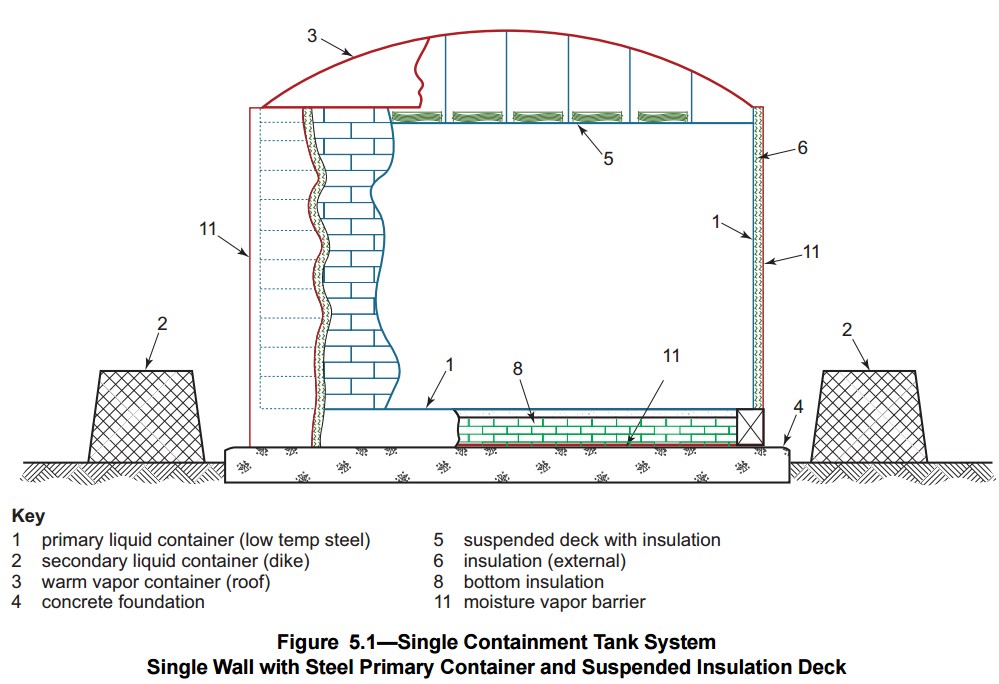

🧱 Double-walled tanks (steel–steel or steel–concrete)
These tanks are used for very low-temperature products, such as LNG, methane, ethane or ethylene, which require a more robust thermal design. In this type of configuration:
The inner tank contains the cryogenic product.
The external tank provides secondary containment in the event of a leak.
Between the two is located the annular space, which generally has a width of 0.8 to 1.2 meters, and is defined by considering:
o The thickness of the thermal insulation required
o The space needed for installation and maintenance
o The expected thermal and structural deformations
This annular space is filled with dried expanded perlite or can be inerted with nitrogen, thus improving overall insulation and preventing the formation of moisture or ice.
📌 When are double-walled tanks used?
The use of double-walled tanks is technically and normatively justified in the following cases:
Storage of cryogenic products at extremely low temperatures (–105 °C to –198 °C), where very low BOG values are required.
Requirement for integrated secondary containment, rather than external systems such as reservoirs or dikes.
Space limitations in urban areas, compact plants, or port terminals where it is not feasible to build additional infrastructure.
Better seismic behaviour, especially in highly dangerous areas. The external tank, particularly if it is made of concrete, helps to stabilize the structure in the face of dynamic stresses.
Need for inerting or condensation control, thanks to a controlled annular space that improves thermal safety.
🔩 Common types of double-walled:
Steel-steel: Offers greater modularity and speed of assembly. Ideal for projects where prefabrication and transport are decisive.
Steel-concrete: Provides high structural strength, durability and thermal stability. It is used in large terminals or seismically active sites.
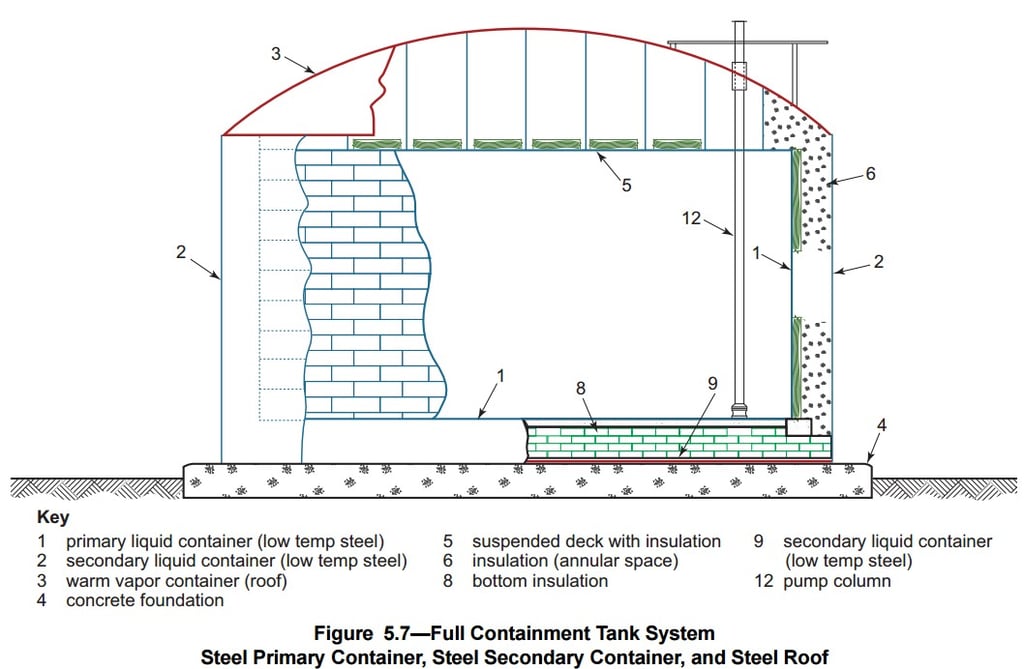

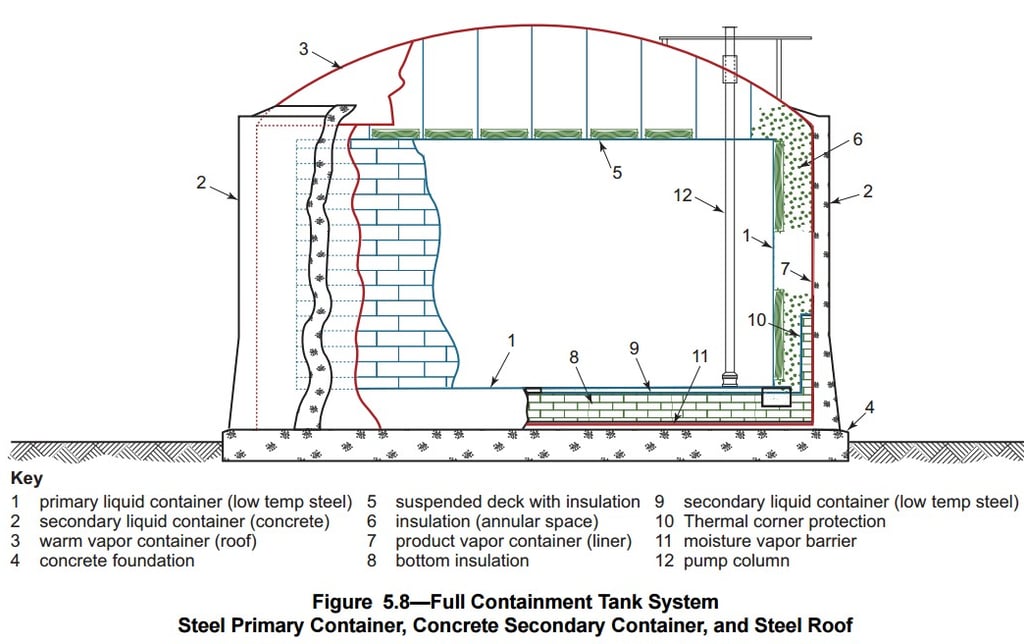

7. Thermal Insulation by Zone
🧱 Wall
The tank walls use resilient blanketing insulation that allows the thermal expansion and contraction of the steel to be absorbed without loss of performance. In double-walled tanks, the annular space can be filled with dry expanded perlite, ideal for its low thermal conductivity (~0.025 W/m·°K).

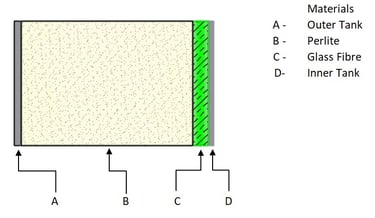
🧱 Bottom
Single-wall tanks:
Under the wall: A concrete ring block with perlite is installed , foamglas or insulating wood.
Central area of the bottom: Layers of thermal insulation (foamglas, mineral wool, etc.) are placed directly on the foundation, protected by a layer of dry sand or concrete.
Double-walled tanks:
Inner Tank Bottom: Same configuration as a single-wall tank.
Outer Tank Bottom:
o It can be supported directly on the foundation slab, or
o Have an insulation system with:
§ Bottom Layer: Leveling Concrete
§ Middle layer: Thermal insulation (foamglas or other insulation)
§ Top layer: Concrete or dry sand.
This solution improves insulation without compromising structural stability.
🧱 Roof
The roof is insulated from the inside using a suspended roof, which hangs from the upper tank structure and supports cryogenic insulation without direct contact with outside solar radiation. This solution avoids excessive thermal loads and protects the stored product.
8. Types of Insulation Used
Expanded perlite: For annular filling, excellent cryogenic behavior (~0.025 W/m· °K)
Foamglas: High mechanical strength, good insulation (~0.045 W/m·°K)
Rigid foams (PUR/PIR): Used in intermediate layers, low conductivity (~0.022–0.03 W/m·°K)
Mineral wool: For general insulation in non-cryogenic areas (~0.045 W/m·°K)
9. Conclusion
The calculation of the BOG and the design of thermal insulation in refrigerated tanks must be carried out accurately to ensure the efficiency and safety of the system. The proper selection of the tank type, the configuration of its structural components and the combination of insulating materials makes it possible to comply with strict daily evaporation limits.
Appendices Q and R of API 620 provide the essential regulatory guidance to achieve these goals, while tools such as ASHRAE-based thermal models ensure a robust design against actual site climatic conditions.
10. Technical References
API 620 – Design and Construction of Large, Welded, Low-Pressure Storage Tanks, American Petroleum Institute, última edición vigente.
API 625 – Tank Systems for Refrigerated Liquefied Gas Storage.
ASHRAE Handbook – Fundamentals.
UNE-EN 14620 – Tanks for the Storage of Refrigerated Liquefied Gases.
Sener Ingeniería y Sistemas – Estudios sobre diseño térmico en terminales de GNL.
Thermophysical Properties of Chemicals and Hydrocarbons, Carl L. Yaws.
Chart Industries Technical Papers.
Linde Engineering – Cryogenic Storage Solutions.
US DOE – Guidelines for LNG Systems.
11. Glossary of Terms
BOG (Boil-Off Gas): Gas evaporated from cryogenic liquid due to heat ingress.
Latent heat of vaporization (λ): Energy required to evaporate 1 kg of liquid without increasing temperature.
Secondary Containment: Additional structural barrier to prevent leakage.
Double-walled tank: Configuration with an internal and an external tank.
Annular spacing: Area between inner and outer walls, usually insulated.
Expanded perlite: Granular insulator with very low conductivity (~0.025 W/m·K).
Foamglas: Insulating and resistant cellular glass.
PUR/PIR: Rigid polyurethane or polyisocyanurate foams.
Sun-air temperature: Effective temperature considering solar and ambient radiation.
Suspended Ceiling: An interior ceiling that hangs from the tank and supports the insulation.
Appendix R (API 620): For tanks between +4°C and –51°C.
Appendix Q (API 620): For tanks down to -198 °C.
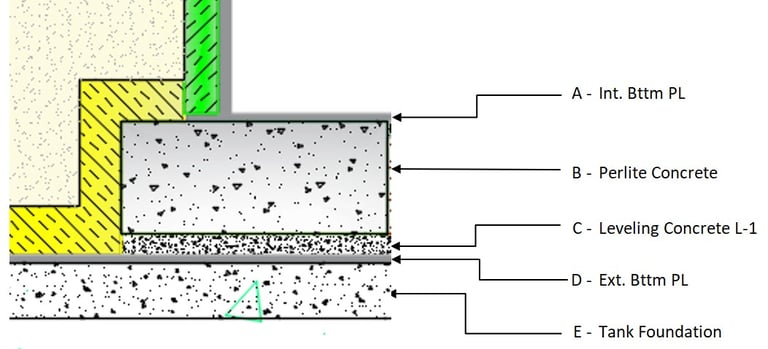

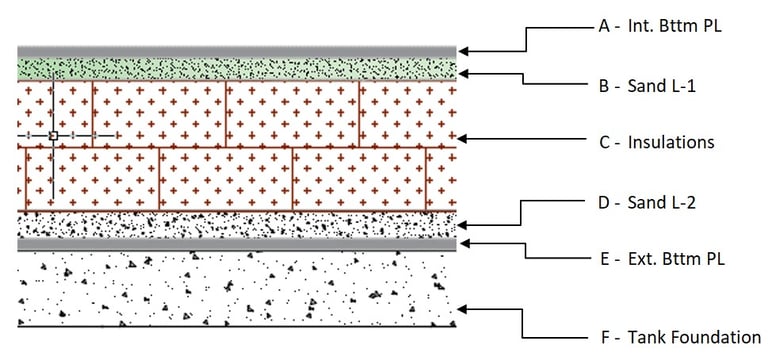

Details
engineering
info@aceinteca.com
© 2024. All rights reserved.
Technical Information for Tank Equipment Courtesy of World Bridge Industrial Co. Ltd.
Technical Information for Tanks Protection Devices Courtesy of Korea Steel Power Corp.
Technical Information for Bolted Tanks Courtesy of Center Enamel.
Glass Fused Steel Bolted Tanks
Stainless Steel Bolted Bolted Tanks
Aluminum Suspended Deck for Cryogenic Tanks.
Aluminum Rolling Ladder for External Floating Roofs
WhatsApp +58 416 6289796
